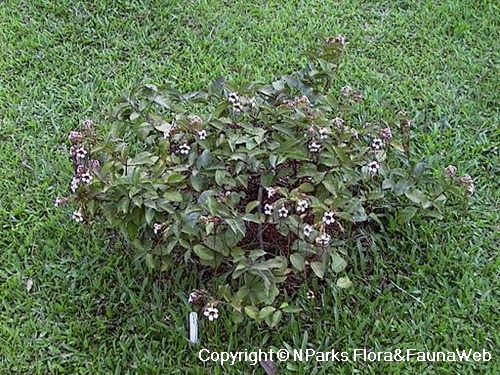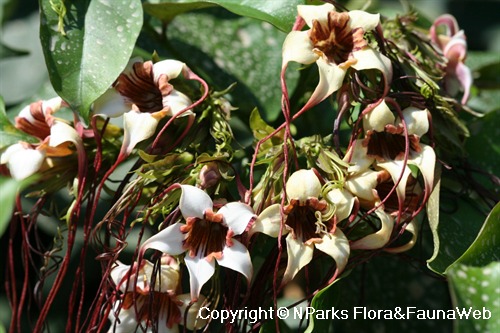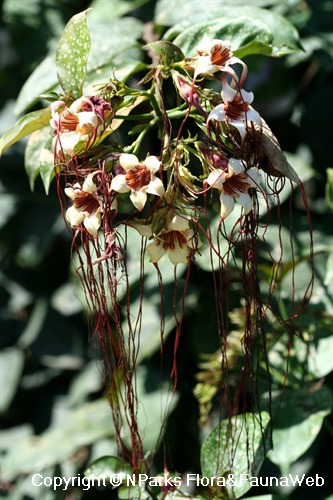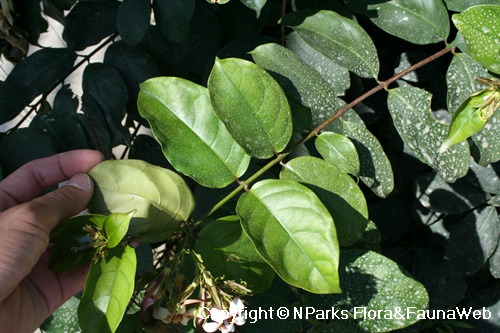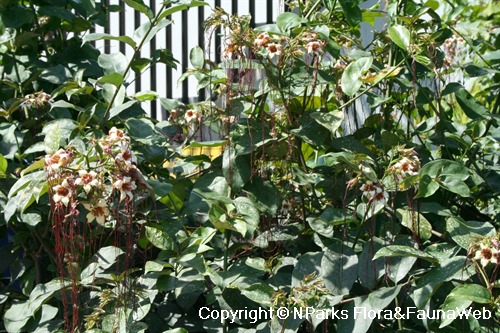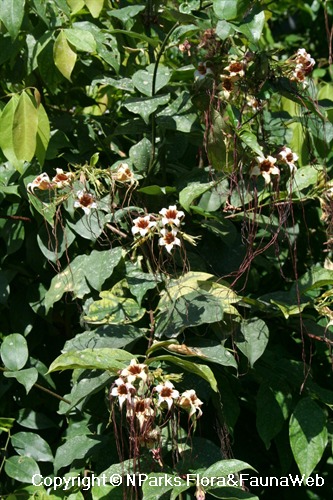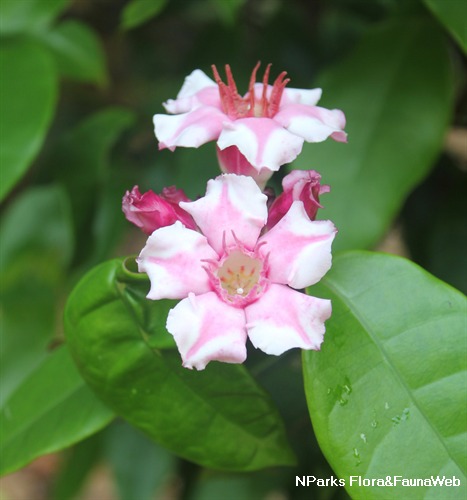
Back
Strophanthus preussii Engl. & Pax.
| Family Name: | Apocynaceae |
| Synonyms: | Strophanthus bracteatus |
| Common Name: | Corkscrew Flower, Poison Arrow Vine, Spider Tresses, Tassel Vine, Climbing Oleander |
Name
Classifications and Characteristics
| Plant Division | Angiosperms (Flowering Seed Plants) (Dicotyledon) |
|---|---|
| Plant Growth Form | Climber, Shrub |
| Lifespan (in Singapore) | Perennial |
| Mode of Nutrition | Autotrophic |
| Plant Shape | Irregular |
| Maximum Height | 0.7 m to 4.0 m |
| Maximum Plant Spread / Crown Width | 3.5 m |
Biogeography
| Native Distribution | Tropical Africa |
|---|---|
| Native Habitat | Terrestrial (Secondary Rainforest, Monsoon Forest) |
| Preferred Climate Zone | Tropical, Sub-Tropical / Monsoonal |
Description and Ethnobotany
| Others - Plant Morphology | Woody scrambling shrub or weak climber. Grown for unusual-looking flowers whose petals are attractively fringed with maroon-purple "streamers" of up to 30cm length.Flowers clustered in bunches, slightly fragrant. maroon throat, petal colour ages from white to cream to pale yellow.Injured plant surfaces produce toxic milky-white sap. |
|---|---|
| Ethnobotanical Uses | Food (Herb or Spice) Others: Stems used to make bows in Nigeria. Seeds contain toxic alkaloids and sometimes used as poison. Tannin-rich sap used to treat wounds, sores and venereal diseases. |
Landscaping Features
| Desirable Plant Features | Ornamental Flowers, Fragrant (Flowers) (Day) |
|---|---|
| Landscape Uses | General |
| Thematic Landscaping | Fragrant / Aromatherapy Garden, Naturalistic Garden |
| Usage Hazard - Cons | Toxic Upon Ingestion |
| Usage Hazard - Cons Remarks | Plant sap contains toxic alkaloids. |
Fauna, Pollination and Dispersal
| Seed or Spore Dispersal | Abiotic (Explosive Dehiscence) |
|---|
Plant Care and Propagation
| Light Preference | Semi-Shade, Full Sun |
|---|---|
| Water Preference | Moderate Water |
| Plant Growth Rate | Moderate |
| Rootzone Tolerance | Fertile Loamy Soils, Well-Drained Soils |
| Maintenance Requirements | Moderate |
| Propagation Method | Seed, Stem Cutting |
Foliar
| Foliage Retention | Evergreen |
|---|---|
| Mature Foliage Colour(s) | Green |
| Mature Foliage Texture(s) | Smooth, Glossy / Shiny, Raised / Sunken Veins, Thick |
| Foliar Type | Simple / Unifoliate |
| Foliar Arrangement Along Stem | Opposite |
| Foliar Shape(s) | Non-Palm Foliage (Ovate, Obovate, Elliptical) |
| Foliar Venation | Pinnate / Net |
| Foliar Margin | Entire |
| Foliar Apex - Tip | Cuspidate |
| Foliar Base | Rounded / Obtuse |
| Typical Foliar Area | Notophyll ( 20.25cm2 - 45 cm2 ) |
| Leaf Area Index (LAI) for Green Plot Ratio | 4.5 (Shrub & Groundcover - Dicot) |
Non - Foliar and Storage
| Bark Colour(s) | Reddish-brown, purplish-brown |
|---|---|
| Stem Type & Modification | Woody |
| Root Type | Underground (Fibrous Root) |
Floral (Angiosperm)
| Flower & Plant Sexuality | Bisexual Flowers |
| Flower Colour(s) | Cream / Off-White, Purple, Red, White |
|---|---|
| Flower Symmetry | Radial |
| Individual Flower Shape | Campaulate / Bell-shaped |
| Inflorescence Type | Panicle |
| Flowering Period | Free-Flowering |
| Flowering Opening Time | Daytime |
| Flower Lifespan on Plant | Several Days |
| Flowering Habit | Polycarpic |
| Inflorescence Size Remarks | Flower colour darkens from white to cream to pale yellow; Maroon-purple markings on tube and petals remain unchanged. |
Fruit, Seed and Spore
| Mature Fruit Colour(s) | Brown |
|---|---|
| Fruit Classification | Simple Fruit |
| Fruit Type | Dehiscent Dry Fruit , Silique |
Image Repository
Others
| Master ID | 211 |
|---|---|
| Species ID | 1507 |
| Flora Disclaimer | The information in this website has been compiled from reliable sources, such as reference works on medicinal plants. It is not a substitute for medical advice or treatment and NParks does not purport to provide any medical advice. Readers should always consult his/her physician before using or consuming a plant for medicinal purposes. |

